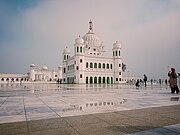Sikh architecture
This article includes a list of references, related reading or external links, but its sources remain unclear because it lacks inline citations. (January 2010) |
|
|
|

Sikh Architecture is a style of architecture that was developed under Sikh Empire during 18th and 19th century in the Punjab region. Due to its progressive style, it is constantly evolving into many newly developing branches with new contemporary styles. Although Sikh architecture was initially developed within Sikhism its style has been used in many non-religious buildings due to its beauty. 300 years ago, Sikh architecture was distinguished for its many curves and straight lines; Shri Keshgarh Sahib and the Sri Harmandir Sahib (Golden Temple) are prime examples.
Sikh Architecture is heavily influenced by Mughal and Islamic styles. The onion dome, frescoes, in-lay work, and multi-foil arches, are Mughal influences, more specially from Shah Jahan's period, whereas chattris, oriel windows, bracket supported eaves at the string-course, and ornamented friezes are derived from elements of Rajput architecture.

Apart from religious buildings, Sikh architecture includes secular forts, bungas (residential places), palaces, and colleges. The religious structure is called gurdwara (a place where the Guru dwells). The word gurdwara is a compound of guru (guide or master) and dwara (gateway or seat). So, it has an architectural connotation. Sikh gurdwaras are generally commemorative buildings connected with the ten gurus in some way, or with places and events of historical significance. Some examples are Gurdwara Dera Sahib (halting place), in Batala in Gurdaspur district. It was erected in memory of the brief stay of Guru Nanak along with his companions on the occasion of his marriage. Gurdwara Shahid Ganj (Martyr's Memorial) in Muktsar in Faridkot district commemorates the cremation spot of Sikhs who were killed in a battle between Guru Gobind Singh and the Mughals in 1705. Gurdwara (hall of mirrors) in Kiratpur in Ropar district was made where Guru Har Kisan was born.
There are over 500 historical gurdwaras.
Gallery[]

Golden dome of Gurdwara Dera Sahib in Lahore

The Gurdwara Janam Asthan in Nankana Sahib, Pakistan, commemorates the site where Guru Nanak is believed to have been born. It was rebuilt by the Pakistani Government

Darbar Sahib, gurdwara commemorating Guru Nanak, in Kartarpur, Pakistan

Shri Hazoor Sahib is a gurdwara in Nanded, Maharashtra, India; is one of the five takhts.

Gurudwara Bangla Sahib is one of the most prominent Sikh gurdwara in Delhi, India and known for its association with the eighth Sikh Guru, Guru Har Krishan, as well as the pool inside its complex, known as the "Sarovar."
References[]
- Arshi, Pardeep Singh, Sikh Architecture in the Punjab, Intellectual Pub. House, 1986.
- Brown, Percy, Indian Architecture (Islamic Period), Fifth Edition, 1965, Bombay.
- Brown, Percy, Indian Architecture (Hindu and Buddhist Period), Fifth Edition, 1965, Bombay.
- Singh, Mehar, Sikh Shrines In India, Publications Division, Government of India, 1974, New Delhi.
- Singh, Darshan, The Sikh art and architecture, Dept. of Guru Nanak Sikh Studies, Panjab University, 1987.
- Marg, Volume XXX, Number 3, June 1977, Bombay.
Further reading[]
- Rajwant Singh Chilana (2005). International Bibliography of Sikh Studies. Springer Netherlands. ISBN 978-1-4020-3043-7.
- Kerry Brown, ed. (1999). Sikh Art and Literature. Routledge. ISBN 978-0-415-20289-3.
External links[]
| Wikimedia Commons has media related to Sikh architecture. |
- Sikh architecture
- Architectural styles
- Indian architectural history
- Pakistani architectural history








